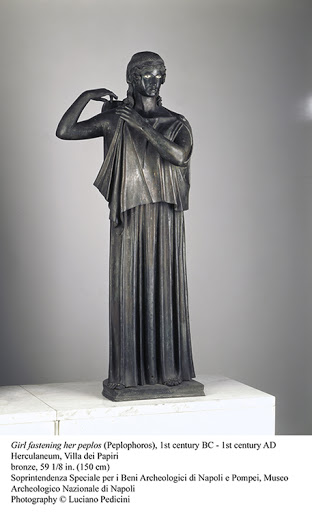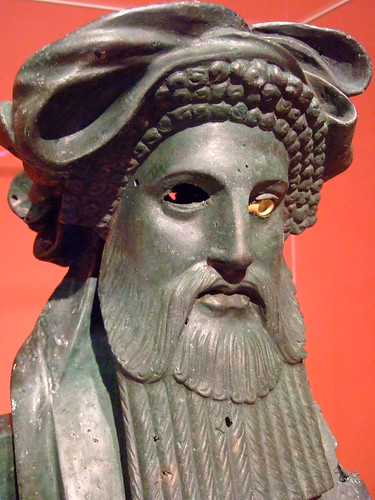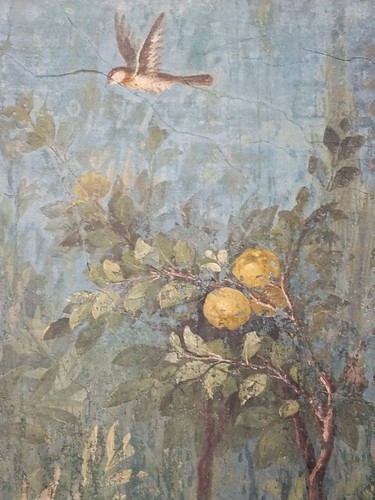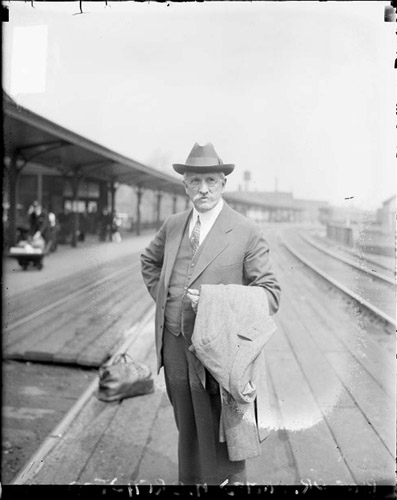 Each time I visit Pompeii I discover something new that I had not seen before. Likewise, with exhibits about Pompeii and the ancient Roman communities surrounding Mount Vesuvius, I learn something about Roman culture that I had not encountered before. Last week when I attended the exhibit, “Pompeii and the Roman Villa: Art and Culture Around The Bay of Naples” at the Los Angeles County Museum of Art, I was fascinated by information about and examples of archaeized Roman art of the 1st century BCE – 1st century CE.
Each time I visit Pompeii I discover something new that I had not seen before. Likewise, with exhibits about Pompeii and the ancient Roman communities surrounding Mount Vesuvius, I learn something about Roman culture that I had not encountered before. Last week when I attended the exhibit, “Pompeii and the Roman Villa: Art and Culture Around The Bay of Naples” at the Los Angeles County Museum of Art, I was fascinated by information about and examples of archaeized Roman art of the 1st century BCE – 1st century CE.
Archaism is the term applied to art produced after 480 BCE that incorporates stylistic elements used in Greek art of the archaic period (700-480 BCE). These elements include facial features, such as hair with spiral or corkscrew or tight curls across the forehead, high cheekbones, heavy lidded eyes or a slight smile.
I was particularly fascinated by this 1st century BCE bronze bust of a youth or the god Apollo found in the remains of the Villa dei Papiri in Herculaneum. Not only does he exhibit the corkscrew curls and faint smile but displays the rounded eyes with flat irises and wears a taenia, or ancient Greek fillet or ribbon, below a skull cap often seen on Kouros-type 6th century grave monuments. I smiled when I read that the curators of this exhibit speculated if the Roman patron who purchased this beautifully executed work actually knew it was contemporary and not an authentic Greek antiquity. They drew attention to the irregularly-shaped lower edge of the bust and said this “defect” might have  been purposefully used to give the impression the bust was broken off from a larger authentic work.
been purposefully used to give the impression the bust was broken off from a larger authentic work.
Faking it
It reminded me of an article I read in Archaeology Magazine a few months ago discussing how quality-made forgeries sold on eBay were becoming so lucrative that many indigenous looters had abandoned scrabbling in the dirt for authentic finds and set up shop cranking out forgeries because it was more profitable.
Scholars also identify several archaeistic poses. Figures sculpted during the Greek archaic period often stand stiffly straight, although occasionally one leg will be placed slightly forward. They usually stare straight ahead without the more casual incliniation of the head seen in later Hellenistic pieces. Women are attired in a Greek peplos instead of the Roman stola with the folds of the fabric hanging straight with a broad central pleat. This 1st century BCE – 1st century CE bronze example of a girl fastening her peplos, demonstrates the stiff posture of typical archaic art. She stares straight ahead without even looking at the brooch she is attempting to secure. Emulating the archaeic style of 5th century Greek art, the sculptor poses her stiffly to lend an otherworldy aspect to her appearance.
Scholars speculate that artists like those of the period hightlighted in this exhibit may have used retrospective style elements to lend their work a divine or otherworldly aspect. Archaeism also  represented a steadfast or enduring quality.
represented a steadfast or enduring quality.
Head Boys
Herms – heads carved on a shaft of stone – served as boundary markers in both ancient Greece and Rome. Although the first herms depicted Hermes, the Greek god of boundaries and patron of travellers, later herms, several included in this exhibit, represent popular figures like the playwright Menander. Herms often included archaistic elements to provide the impression of stability and authenticity.
This herm of Dionysos with tight snail shell curls above his brow can be seen nearby at the Getty Villa in Malibu, California. Visitors to the Pompeii exhibit at the Los Angeles County Museum of Art are given a ticket for admission to the Getty Villa. Although admission is always free at the Getty, reservations are normally required. That stipulation is waived with the ticket from LACMA.
Scholars also think older styles were used in religious iconography to imbue the sculptures of gods and goddesses with venerability. Of course, Romans also liked to emulate their own celebrities and the art they admired. The emperor Augustus was widely known to be a big fan of classical Greece and his influence was still evident even 65 years after his death.
Fruity Frescoes
I couldn’t help but compare the beautiful garden fresco from the House  of the Golden Bracelet displayed in this exhibit with the frescoes from the triclinium of the Villa of Livia I had seen at the Palazzo Massimo Alle Terme of the Museo Nazionale Romano in Rome this past March. Enclosed by a simple wicker fence, Livia’s garden contains a luxuriant mixture of trees and plants including laurel, palms, fir, and fruit trees like pomegranates as well as many different species of birds and flowers. Although both are beautifully rendered, I think I prefer Livia’s version without the intruding herms and theater masks.
of the Golden Bracelet displayed in this exhibit with the frescoes from the triclinium of the Villa of Livia I had seen at the Palazzo Massimo Alle Terme of the Museo Nazionale Romano in Rome this past March. Enclosed by a simple wicker fence, Livia’s garden contains a luxuriant mixture of trees and plants including laurel, palms, fir, and fruit trees like pomegranates as well as many different species of birds and flowers. Although both are beautifully rendered, I think I prefer Livia’s version without the intruding herms and theater masks.
Towards the end of the exhibit I also enjoyed seeing “A Sculpture Gallery” painted by one of my favorite artists, Sir Lawrence Alma-Tadema, in 1874. Although a renowned painter in Victorian Britain, he was actually born in The Netherlands in 1836. By the age of four he was attempting to draw his first sketches and when he joined his older brothers’ drawing classes, he had the audacity to correct his tutor’s perspective.
His only other passion was history (a man definitely after my own heart!) and he produced 26 little pencil sketches of Greek gods and goddesses at the age of 12 that survive to this day. Although he attended the prestigious
“Pompeii and the Roman Villa: Art and Culture Around The Bay of Naples” will be exhibited at the Los Angeles County Museum of Art until October 4, 2009. The exhibit was prepared by the National Gallery of Art with support from the Los Angeles County Museum of Art. The National Gallery of Art also published a fascinating brochure in pdf format about the objects selected for inclusion in the presentation. Their feature-rich website also includes a video narrated by Sir Derek Jacobi (Claudius to you “I, Claudius” fans) and teaching “Discovery Guides”.

